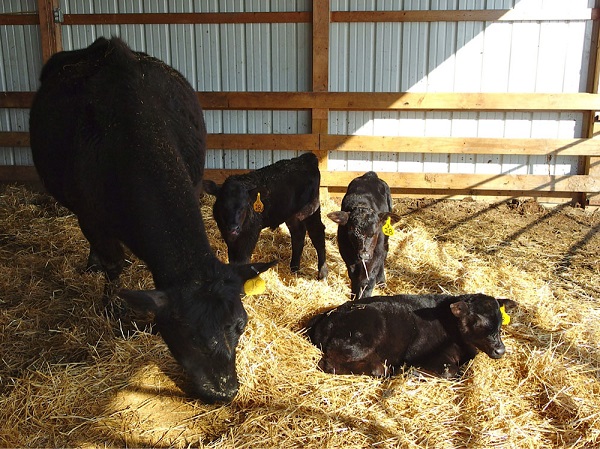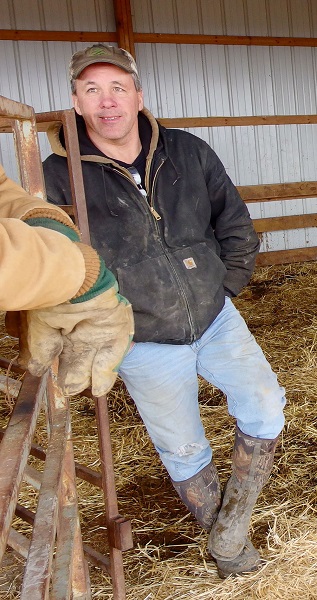
The Hancock-Henderson Quill, Inc.

Ron Johnson, south of La Harpe, has been raising cattle on his corn and soybean farm for 30 years, but he received a surprise on Thursday, February 11th around 6 o'clock when his 15-year old Angus cow delivered a set of black triplet heifers, all alive and doing well.
"I haven't touched them!" Johnson said, when asked if he had to bottle feed any of the three.
All three were up in about ten minutes and nursing with their proud mother. They weighed around 50 lbs. each and in two weeks have nearly doubled their weight, he said.
The bull (or bulls) that are responsible belong to Rod Campbell. Three bulls were turned in with the cow so it could be possible that they all have different dads, Johnson amused.
Johnson has already had two of his cows deliver twins this year, but this is the first set of triplets. Out of his 50 cows he hopes to have 50 nice feeder calves, but he's already ahead by 4, he said.
According to Ron, neither he nor his dad Eugene Johnson had ever seen triplets born.
Ron said Jon Schar, Stronghurst veterinarian, has only seen one other live set of triplets born, but has seen two sets of triplets that were born dead.
Triplets are a rare sight among beef cattle herds. In fact, according to a report from the University of Illinois, the incidence of triplets is rarely to .2% or about one in every 130,000 cavings where twins in Angus cattle have reports of 1 out of each 100 births.
A report that many articles have quoted on the rarity of triplets seems to have come from a very old paper published in 1920 Journal of Dairy Science by Jones and Rouse. It indicated triplets in beef cattle averaged 1 in 105,000 births but was more likely to occur in Brown Swiss (1 in 3500 births). The report also said that "cattle owners must remember that when a heifer calf is born twin to a bull, she is very likely sub-fertile, if not sterile and should not be kept as potential replacement heifers."
A more recent report appeared about triplets being born on the Mitch England farm 20 miles outside Creston, IA the same night Creston was hit by a tornado in 2012. Three bulls were all born that night with the odds of triplet bulls being reported in that story as only happening 1 in 700,000.
Melinda England had stated, "It was just starting to rain and the cow was struggling for a couple hours so they brought the cow into the barn to assist with a breach or if it might be twins. The whole England family (Mitch, Melinda, and sons Ryan and Brett) were there to deliver their surprise package of triplets that April 14th evening. Like Johnson and his heifers, they left the barn with all three bulls standing and nursing, healthy and well.
Johnson said it takes a little over 9 months for a cow to be ready to deliver and when the triplet heifers get older they will be fed silage, gluten and hay and then sold as feeder calves to be fed out for market.
That is probably why they are not named but they are numbered to match their mom #28. The triplets are #28-1, #28-2, #28-3. Maybe a good name would be Aberdeen, Angus, and Scottie for their Angus heritage
Ron Johnson and his wife Tracy (Ufkes), have two grown daughters Haeli and Skyer, and a son Ethan, a senior at Illini West High School who works Coop at FS.

Ron Johnson, visits about the first set of triplet Angus calves born at his farm.